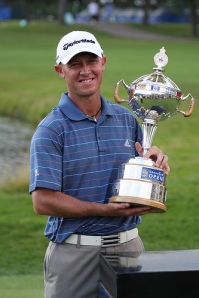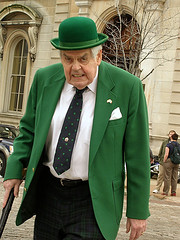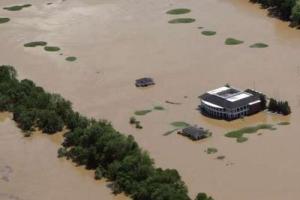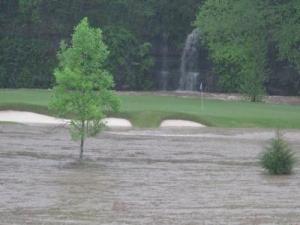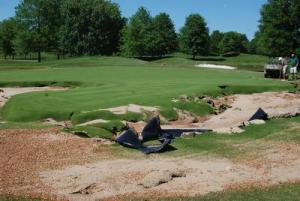*I apologize in advance for this off-topic post about my first marathon experience. I know I’m breaking a cardinal rule of blogging. But I thought I’d post it here first for any fellow golfers/runners/friends/family who would like to offer feedback. It’s a long one, so bear with me.
Six More Miles: The Strange Story of My First Marathon
That final step was supposed to be different. Not like this.
As I stepped across the finish line, I unwillingly entered one of the strangest paradoxes of my entire life. This was supposed to be a moment of glory, a lifetime accomplishment, but I had never felt more defeated.
How could this happen? How could I spend 16 weeks training for my first full marathon—running 373 miles and burning 45,000 calories over the course of four months—for it all to end like this: teary-eyed, angry, soaked from head to toe, less than 6 miles short of marathon distance, at the wrong finish line, and franticly looking for a race official to unload my fury upon.
Where did everything go wrong?
A Painful Start
A year earlier, I stood a few hundred yards away from that exact location and watched as a friend completed the final steps of his second marathon under sunny skies and in unbearable heat. That’s when something inside me clicked—I could do this. Forget that I’d never run more than two miles at one time, forget that I’d always hated running, forget that I was horribly out of shape…I could do this next year.
At the time, I laughed at myself for even thinking that I could transform from an out-of-shape-approaching-middle-age-non-runner to a marathon runner in a year’s time. Ridiculous. Nothing more than a pipe dream.
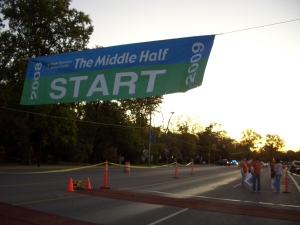
The start line at my first half marathon. October 2009.
My cynical side took over: While you’re at it, Robert, why not become an astronaut? You’ve got be kidding yourself, dude…you can’t run a marathon.
With those negative thoughts in my head, I started running. Well, I started walking with a little running thrown in for good measure. I ran for a minute or two in between labored walks. My first jog was an out-of-breath one-third of a mile trot. It wasn’t pretty.
I wasn’t obese. I wasn’t recovering from some dramatic life-altering surgery. I was just like most Average Joe Americans—out of shape and unmotivated to change.
Change came slowly. My body—mainly, my lower legs—stayed angry with this new lifestyle. I ran three days a week for a couple of months—each run accompanied with a new sensation of pain: tightness, discomfort, cramping.
While fitting me for running shoes, the owner at my local running store was shocked at the amount of tightness in my calves.
“How much have you been running lately,” she asked, probably thinking my leg condition indicated a recent half marathon.
“Well, I ran a mile yesterday,” I answered with a hint of shame in my voice.
After a couple of months of running three days a week, I painfully worked my endurance up to about 2 miles—a minor miracle at the time. During the next few months, my endurance improved drastically. By November, I completed my first and second half marathons—each in just over two hours. (Read about my first half marathon here.)
To me, the next step was obvious. In December, I signed up for my first full marathon without hesitation.
The Marathon
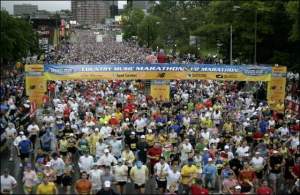
35,000 runners getting started at The Country Music Marathon.
April 24, 2010. The Country Music Marathon in Nashville —my hometown. I marked the date on my calendar. I downloaded a countdown clock for my iPhone. No way, I told myself, would I fail at this. Sixteen weeks to prepare.
On January 4, my regimen of marathon training began—a simple and slow three-mile run in 24 degree temperature. I learned quickly that training for a marathon is an entirely different beast than training for a half marathon. Right off the bat, my long run was eight miles. My Saturday runs included 18, 20, and 22 milers. Running became a part-time job.
As race day approached, I obsessed over the weather. The forecast called for severe thunderstorms. The day before the marathon, race officials announced that—because of the impending severe storms—all full marathon runners who weren’t maintaining a 10:20 pace by mile 11 would be sent to the half marathon finish line. The bad weather was supposed to arrive mid-day, and they wanted everyone off the course.
As if a marathon isn’t enough of a psychological battle, now I was forced to stay on a certain pace which, coincidentally, was the exact pace I needed to finish on my 4:30 goal time. Find the 4:30 pace runner and stay ahead of her, I told myself.
On the morning of April 24, I woke up at 4:45 a.m. with a bounce in my step. Race day had finally come. My wife, Katie, and I drove to the Vanderbilt parking lot, just a few hundred yards away from the starting line on West End Avenue.
Tears welled in my eyes as we sat in the car and talked. She told me how proud she was of me. No longer was I simply talking about and dreaming of running a marathon, I was about to run one.
When I stepped out of the car, I could almost see the humidity. Storms had rolled in during the night, and storms were coming in the afternoon. The air was moist and thick—just another obstacle to overcome, I thought.

Standing in my corral shortly before the race.
We walked slowly to corral 16—right in the middle of the pack. Within 30 minutes, more than 35,000 runners would line up on West End. Katie stood outside the ropes, talking to me and trying to keep my nerves down. My heart rate, which usually rests at 75 bpm, was at 130 bpm—and I hadn’t even started running yet. My adrenaline was in overdrive.
I crossed the start line at 7:02 a.m. without a clue of how the next four hours would unfold. The first clue came within 30 minutes.
The third mile follows a slow, steep hill up Demonbreun Street in downtown Nashville. By the time I reached a water station at the top of the hill, I already knew something with my body wasn’t right.
Each breath I took seemed to bounce off the humid air and float back into my face. I poured water over my head at the second water station—not a good sign.
I moved through Music Row and Belmont without too much difficulty, though my pace was about 20 seconds slower than I had hoped for at that point.
Sometime during mile 8, I grimaced as the four-and-a-half-hour pacer slowly jogged past me. Keep her in sight. Keep her in sight, I thought. But as I watched her move ahead through the crowd of people, I knew I couldn’t keep up anymore.
My pace was slower than during any of my extended training runs. Whether it was the humidity, the heat, the hills, the people, or just the anxiety of running in my first marathon, something was getting to me. I was struggling badly, and I didn’t know how to recover.
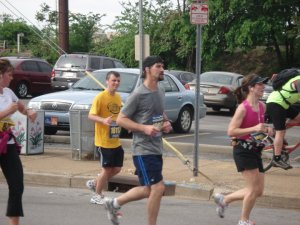
By mile 11, I was already feeling it.
By mile 11, I held a 10:30 pace, about 10 seconds off the predetermined 11.2 mile cutoff time. At this point of the course, the half-marathoners continue on to their finish, less than 2 miles away, and the full marathoners turn left and venture out for 15 more miles.
The marathon route was still open. I turned left and continued on—already winded, fatigued, and wondering if I would live to see mile 26. But I was home free—or so I thought. Though it seemed apparent that I wasn’t going to reach my goal time, at least I was going to finish.
Halfway Home
I started walking for the first time right before the halfway point. How am I this tired already? My calves cramped badly. It seemed as though both of my calf muscles wanted to recede into my legs.
We’ve had enough, they seemed to be telling me as they pulsated with each step and forced me to stop and stretch them out every few hundred yards. My calves had never cramped during training, but the humidity was taking a toll on my body.
The skies darkened as clouds moved in. Around mile 15, we turned right onto a greenway that follows the Cumberland River for a couple of miles. Just before the turn, I noticed a female jogger sitting in a small parking lot and bawling as she held her ankle. Her race was over.
I felt bad for her, but I had to keep moving. A police officer stood a few yards away.
“What’s the weather looking like?” I asked him.
“It’ll be here in about 45 minutes,” he said. “Maybe less.”
Wonderful.
The rain started within 30 minutes. I had just passed the mile 17 marker when a lighting bolt struck a few miles away. Sporadic thunder echoed all around us. I began walking again, chatting with a woman who was limping from a right knee injury.
“This is awesome!” she said. “The rain feels great!”
The rain picked up intensity and the wind began to whip across the highway. Every half mile or so, a police officer would announce over a megaphone: “Runners, there is severe weather in the area. We advise you to take shelter. However, you may continue on if you choose to do so.”
No one was taking shelter. Some of us ran. Some of us walked. But we all kept moving. For the next two miles, I continued walking and lightly jogging to ease some of the cramping in my legs. My upper thighs tightened as the cold rain poured down. My legs hated me.
After a couple of miles of trudging through the storm, the skies lightened and the rain tapered as we moved through the Bicentennial Mall area of the course. Downtown Nashville was once again in sight.
Just more than 7 miles remained. My time goal was out of reach, but I had mentally rebounded and began a steady run again. I found my second wind. I’m going to do this.
A Painful Finish
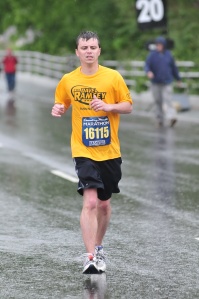
Just past mile 20, right before I found out my marathon was about to end.
After mile 19.5, marathon runners rejoin half-marathoners for a half-mile stretch. As I trotted past mile 20, I realized something was wrong. Orange cones blocked the road ahead. A couple of cops stood in front of my path. Without thinking, I turned right with the half-marathoners only to see LP Field straight ahead.
Oh no, I thought. They are bringing us in. I turned around and walked back toward one of the police officers.
“Where does the marathon route go?” I asked, fearing what he might say next.
“They shortened the course and diverted you guys to the half marathon finish line. More bad weather is coming.”
“You’re kidding,” I said.
“No,” he responded flatly.
“Could someone have told us this a few miles ago?” I said, stunned that my race was ending so abruptly. He didn’t answer.
I briefly considered running past the blockade. Instead, I swung back around and walked toward my new finish line. My face began to grow warm as tears of anger puddled under my eyelids.
At that point, I understood how someone can lose his mind for a minute and do something stupid–like punch a police officer. Maybe I’ve been angrier at some point in my life, but I don’t remember it.
Someone I didn’t even know, some race director in an office somewhere had pulled the rug out from under from my year-long quest to finish a marathon. Hell hath no fury like a marathon runner diverted.
I tried to hold it together as I turned the corner with some of the last half-marathoners who were finishing their race. I passed two women walking with their hands raised up in the air, celebrating their last few steps together before accomplishing their goal. The clock above the half-marathon finish line showed a time of just over four hours.
I slowed to a brisk walk moments before I crossed the half-marathon finish line—furious with the race organizers for yanking us off the course in the middle of a light rain, pissed at myself for struggling so thoroughly during the last 7 miles, angry at the half-marathoners who were celebrating in my moment of defeat.
During my 53 training runs, I must have envisioned that finish line moment dozens of times. How would I react? I thought. Would I cry? Would I yell? Would I raise my hands in victory? Would I fall down from fatigue? Would I run through the crowd and hug my wife? Would I act calm and collected? Would I stop and pray?
Out of all the scenarios that ran through my head, this scenario was not one of them.
That final step was supposed to be different.
The Last Six
The next morning, I woke up late, still depressed and frustrated from the events of the previous day. I hobbled to my computer and read the coverage of the race in the local newspaper. Race organizers explained that pulling the marathon runners off the course was in the best interest of the safety of the runners, spectators, and volunteers.
The weather predictions that caused this almost unprecedented decision were accurate. Within 45 minutes of the time I crossed the half marathon finish line, severe storms with heavy rain and lightning moved into downtown Nashville.
Just under 800 marathon runners, out of the few thousand who started the race, finished the marathon. Thousands of other runners knew exactly how I felt on Sunday morning. But this was my first marathon attempt, and I wanted it badly.
Race organizers said the shortened marathon course measured 20.4 miles. All I lacked to complete my first marathon was 5.8 miles. 5.8 miles.
Without much thought, I walked down the stairs and into the kitchen.
“Katie,” I said, “I’m going to run 6 miles. I know you think I’m crazy. My legs still hurt from cramping yesterday, but I need closure.”
“You do what you need to do,” she said. “Go for it.”
I thought about hopping in the car and driving downtown to mile 20.4. Instead, I walked out into my driveway and just started running. My pace was painfully slow, just under 11 minutes per mile. My legs ached.
I ran the 6 miles in 1:05:16, meaning the unofficial time for my first marathon was 5:10:35. With a makeshift, made-up final six miles, I completed the race—forty minutes slower and 27 hours after I expected to finish.
But I finished—not in front of an audience lining the streets, not at a finish line in front of LP Field. I finished in my driveway—where this strange journey started less than a year earlier.
Starting Over
I gingerly walked inside the house and back up to my living room. The full marathon medal that a volunteer handed me after crossing the 20.4 mile finish line sat on the floor next to my chair. On the other side of the room, my two half marathon medals from last fall were on display next to my bib numbers.
Have I earned that now? I asked myself as I glanced at the sturdy Country Music Marathon medal I had slung on the floor a day earlier. But I knew the answer before I asked the question.
Sure, I had just run 6 miles for some sense of closure, but I hadn’t accomplished my goal. I picked up the marathon medal and placed it inside my desk drawer.
That medal didn’t belong with the others. I hadn’t earned it. Instead of being a symbol of a major accomplishment, the medal was a reminder of a goal I still fiercely wanted to achieve.
I sat down at my desk, pulled up Google on my computer, and typed “2010 marathon schedule.” I still had work to do.

